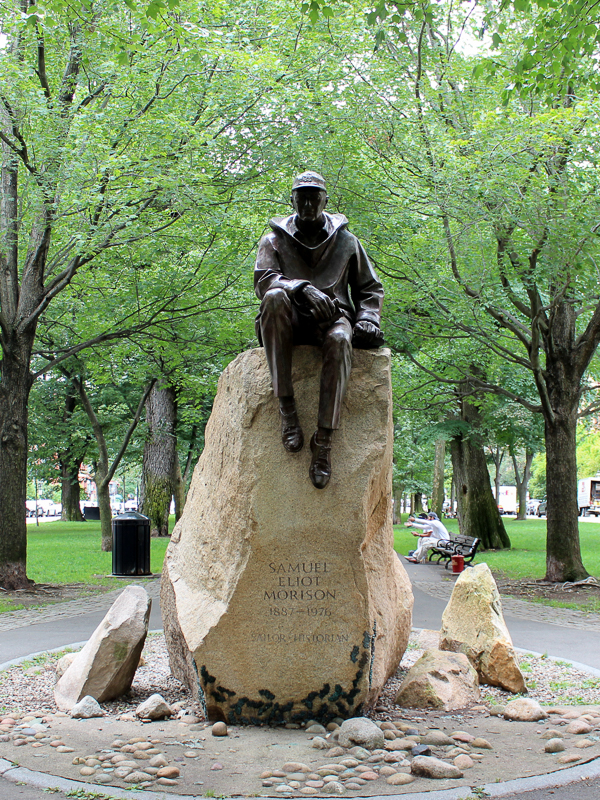 On the Exeter-Fairfield block of the Commonwealth Avenue Mall, you’ll find the statue of Samuel Eliot Morison. It was created by Penelope Jencks, famed sculptor whose commissions include sculptures of Eleanor Roosevelt, Robert Frost, and Aaron Copeland. The Morison sculpture was installed in 1982 and presents a likeness of Morison wearing a casual windbreaker and baseball hat perched atop a natural granite boulder, looking pensively out at the invisible sea beyond, perhaps pondering his own legacy. The circular platform at the foot of the sculpture includes bronze casts of shells, starfish, and crabs, as if at the ocean’s edge. Etched into the rock beside Morison’s sculpture is his counsel to young writers: ”Dream dreams, then write them aye, but live them first.”
On the Exeter-Fairfield block of the Commonwealth Avenue Mall, you’ll find the statue of Samuel Eliot Morison. It was created by Penelope Jencks, famed sculptor whose commissions include sculptures of Eleanor Roosevelt, Robert Frost, and Aaron Copeland. The Morison sculpture was installed in 1982 and presents a likeness of Morison wearing a casual windbreaker and baseball hat perched atop a natural granite boulder, looking pensively out at the invisible sea beyond, perhaps pondering his own legacy. The circular platform at the foot of the sculpture includes bronze casts of shells, starfish, and crabs, as if at the ocean’s edge. Etched into the rock beside Morison’s sculpture is his counsel to young writers: ”Dream dreams, then write them aye, but live them first.”
“I have no imagination. I can’t write about a battlefield until I’ve been over it, nor about sea warfare unless I’ve taken part in it.” With that sentiment, Samuel Eliot Morison put himself in the shoes of explorers like Christopher Columbus and personally retraced the route Columbus took to the New World, writing his story from inside the experience. He also wrote an expansive 15 volume history of World War II from his perspective as a naval officer.
A member of the Boston elite, who was born and raised in Beacon Hill and educated at Harvard, Morison was a well-respected historian, the winner of two Pulitzer prizes, and author of a huge catalogue of work with over 50 books.
In his book, The Growth of the American Republic, first published in 1930, Morison was also criticized for his treatment of American slavery. His book provided an abbreviated and short-sighted view of their struggles, and for many years he refused to update his writings when faced with scrutiny from prominent African American scholars. In the 1962 edition of the textbook, Morison finally did remove the additional content that these critics found offensive.
These statues remind us that the individuals memorialized are complicated and can reflect values of a different time. As art historian Renee Ater said in her essay in Tell it with Pride, “Many monuments force public conversations about what is important to communities and to the nation… They are not static; each individual, neighborhood, and new generation encounters and interprets the meaning in ways that are as fluid as time and space.”
The Friends, in collaboration with the City, is embarking on a groundbreaking project over the next several years to light all the statues on the Commonwealth Avenue Mall. Samuel Eliot Morison is the first statue to be lit. This project is not just an opportunity to make the neighborhood safer, but also a chance to highlight the nine distinctive pieces of public art, and the people they memorialize, on the Mall.

